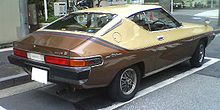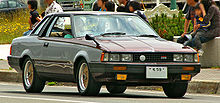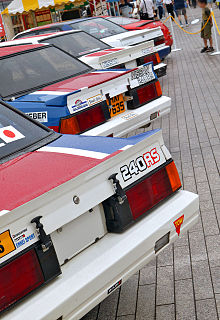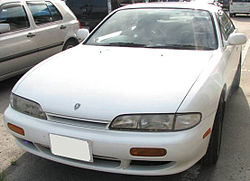- Nissan Silvia
-
Nissan Silvia 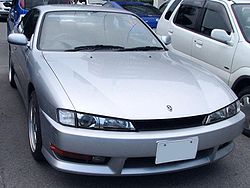
Manufacturer Nissan Production 1964–1968
1974–2002Assembly Iwaki, Fukushima, Japan Successor Nissan Altima L32 Class Sport compact Layout FR layout The Nissan Silvia is the name given to the company's long-running line of sport coupes based on the Nissan S platform. Although recent models have shared this chassis with other vehicles produced by Nissan (most notably the European 200SX and North American 240SX in the S13 and S14 generations, and 180SX in the Japanese market), the name Silvia is not interchangeable with the chassis codes.
Contents
The original Silvia
CSP311 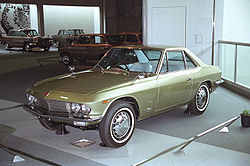
Production 1965–1968
554 producedBody style 2-door coupe Platform Datsun CSP311 platform Engine 1.6 L R OHV I4 Transmission 4-speed manual Wheelbase 2,280 mm (89.8 in) Length 3,985 mm (156.9 in) Width 1,508 mm (59.4 in) Height 1,275 mm (50.2 in) Curb weight 977 kg (2,150 lb) Related Datsun Fairlady SP311 The Nissan Silvia CSP311 made its public debut at the Tokyo Motor Show in September 1964 as the "Datsun Coupe 1500". The introductory model was a hand-built coupe based on the Fairlady convertible, styled with input from Count Albrecht Goertz. The CSP311 was powered by the 96 hp 1.6 L Nissan R series engine. Production ceased in 1968 after a mere 554 were made (mainly in 1965), every one unique with hand-formed body panels. Most of the cars remained in Japan; however, 49 examples were exported to Australia and another 10 went to other countries. The low production numbers and tedious method of construction assured each car was unique and valuable; this is reflected by the car's purchase price of almost twice as much as the next model in the manufacturer's lineup at the time. After production ceased in 1968, the name Silvia would not grace another Nissan until 1974.
The engine was equipped with twin SU carburetors.
S10
S10 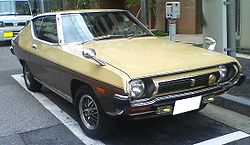
Also called Datsun 200SX (US)
Datsun 180SXProduction 1975–1979 Body style 2-door fastback Platform Nissan S platform Engine 1.8 L L18 SOHC I4
2.0 L L20B SOHC I4Transmission 3-speed 3N71 automatic
5-speed manualWheelbase 2,340 mm (92.1 in) Length 4,135 mm (162.8 in) Width 1,600 mm (63.0 in) Height 1,300 mm (51.2 in) Curb weight 990 kg (2,200 lb) Related Datsun B210 The S10 was the first Silvia built on the S platform. This was "Nissan's compact, rear-wheel-drive, sporty car platform".[1]
The S10 featured more "traditional" lines than similar offerings from rivals Toyota and Mazda and was summarily less popular with consumers in most markets. In Japan it was fitted with an L18 I4 engine, which it shared with the Datsun 610/Bluebird 180B. In the North American market a version incorporating the larger-displacement L20B was offered as the 200B of the same series Bluebird. This model was affixed with the mandated 5 mph (8.0 km/h) bumpers and badged as the Datsun 200SX. The S10 Silvia and Datsun 200SX were based on the B210. Its success in both markets was limited, most buyers opting for the Celica over what was considered the more mundane S-Chassis. The car had the same drivetrain as the cult-classic 510, but with cart springs in the rear rather than the 510's IRS. Its appearance seems to be influenced by the 1970-1975 Citroën SM.
S110
S110 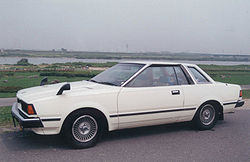
Also called Nissan Silvia (S110) 2-door coupe
Nissan Gazelle 3-door hatchback
Datsun 200SX (United States & Canada)
Datsun Sakura (Mexico)Production 1979–1983 Body style 2-door coupe
3-door hatchbackPlatform Nissan S platform Engine 1.8 L SOHC Z18ET I4
2.0 L SOHC Z20E I4
2.2 L SOHC Z22E I4
2.0 L DOHC FJ20E I4
2.4 L DOHC FJ24 I4 (240RS)Transmission 3-speed automatic
5-speed manualWheelbase 2,400 mm (94.5 in) Length 4,400 mm (173.2 in) Width 1,680 mm (66.1 in) Height 1,310 mm (51.6 in) Curb weight 1,105 kg (2,440 lb) This iteration of the Silvia (sold in United States and Canada as the Datsun 200SX and in Mexico as the Datsun Sakura), available as a 2-door hardtop coupe and a 3-door hatchback, was uniquely progressive in that it was originally intended to feature a rotary engine, designed and built by Nissan. The resulting unit was fairly unreliable, and forestalled production. Coincidentally, it shared a chassis code with the also ill-fated Mazda Cosmo, first Japanese production car to feature a rotary engine. The car was redesigned shortly after it was released and the Wankel power plant was replaced by a line of conventional piston engines based on the new Z-series engine. These included the Z20 and the turbocharged and fuel injected Z18ET, although the latter of the two was only available to the Japanese domestic market. In USA/Canada the 200SX had the Z20E with H165 rear axle from 1979 to 1981. From 1982 to 1983, it had a Z22E engine with H190 rear axle. Vehicles with engines over 2000cc are still considered "compact" vehicles under Japanese regulations regarding engine size.
Nissan 240RS
This generation saw the introduction of the Nissan 240RS (BS110), a coupe fitted with the 2.4 liter DOHC FJ24 engine. The 240RS was built between 1983 and 1985, its production extending the end of the S110 itself. The resulting monster became Nissan's official rally car in the World Rally Championship from 1983 to 1985, and finished 2nd in the 1983 New Zealand Rally.
S12
S12 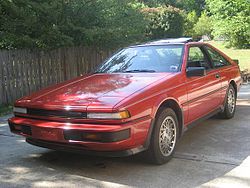
Also called Nissan 180ZX (Sweden)
Nissan 200SX (North America)
Silvia (EU and JP)
Nissan GazelleProduction 1984–1988 Body style 2-door coupe
3-door hatchbackLayout FR layout Platform Nissan S platform Engine 2.0 L SOHC CA20E I4
1.8 L SOHC Turbo CA18ET I4
1.8 L DOHC Turbo CA18DET I4
3.0 L SOHC V6 VG30E
2.0 L DOHC FJ20E I4
2.0 L DOHC Turbo FJ20ET I4Transmission 5-speed manual
4-speed L4N71/E4N71 automaticWheelbase 2,425 mm (95.5 in) Length 1984-86: 4,430 mm (174.4 in)
1987-88: 175.6 in (4,460 mm)Width 1984-86: 1,660 mm (65.4 in)
1987-88: 65.7 in (1,669 mm)Height 1984-86: 1,330 mm (52.4 in)
1987-88: 50.4 in (1,280 mm)Curb weight 1,170 kg (2,600 lb) Related Nissan 300ZX The S12 was produced from 1984 to 1988, with revisions to the exterior trim in 1987 (referred to as "Mark II"). It was sold in three configurations—a coupe (often called a "notchback"), a hatchback, and a widebody chassis called grandprix (only 50 units made worldwide).
A number of different engines were equipped in the S12 chassis, depending on production year and more specifically on the geographic market. These engines borrowed from previous designs, or in some cases, inspired future engine platforms (with the exception of the FJ series, which was designed solely with Rally competition in mind). For instance, the CA series initially borrowed design cues from the NAP-Z series. The CA18DET's DOHC head design was similar to that utilized in the later "RB" engine series, the inline-six engine that powered the Skyline GT-Rs. The VG30 V6 engine was also used, the VG is the predecessor to Nissans VQ Engine.
Regional badgings
North America
The S12 chassis in North America was badged "200SX". The Coupe was available with a 2.0 L SOHC engine (CA20E), while the fastback received both the 2.0 L SOHC engine, and a 1.8 L SOHC Turbo (non-intercooled) engine (CA18ET). For 1987 in the United States, Nissan discontinued putting the 1.8 Turbo into the fastback, and created the "SE" model which had the 3.0L SOHC V6 engine (VG30E), generating 160 hp (120 kW) and 174 lb·ft (236 N·m) of torque. This was the same engine offered in the non-turbo 300ZX for that generation. For 1988 the "SE" model received a 5 hp (3.7 kW) gain from using the later "W" series (VG30E) with a total output of 165 hp (123 kW) while torque remains the same at 174. The 200SX was replaced with the S13 Nissan 240SX in 1989.
After the sudden demise of Group B from World rally Championship, Nissan had to quickly find a car to replace the 240RS. The North American 1987 200SX SE V6 was chosen and competed in 1986-89 as a 200SX. Nissan's creation and choice of this car ensured they could sell 5000 cars required for WRC Homologation. The USA market being only one large enough to sell 5000 cars to a single specification. This also implies that they hadn't sold 5000 Japanese market Silvia RS-X with FJ20ET and were unlikely to sell enough with CA18DET, while the CA18ET can't have been considered adequate. The V6 was a very unusual choice as the WRC was dominated by 4 cylinder 2.0 L turbocharged engines, although for similar reasons Toyota entered WRC with the 6 cylinder Supra at the same time. The 200SX achieved a 1st place in the 1988 Ivory coast rally and 2nd place 2 years running in the very arduous East African Safari Rally 1988 and East African Safari Rally 1989. It only competed for a few events in championship, mainly in the events that had a reputation for destroying cars where wining was by attrition. It didn't compete in the northern Europe events that didn't pummel the car but were won on driver skill and lost by accident.
Europe
The S12 chassis in Europe was badged Silvia, and was available in the hatchback and the grandprix configuration. The difference between the hatchback and the grandprix were the widebody, different wheels, and minor interior differences. The engine available was the same 1.8L SOHC Turbo (CA18ET) used in North America, and in some areas the 2.0 L DOHC "FJ" engine (FJ20E). The "FJ" engine series was originally designed for the 240RS rallycar as a 2.4 L carbeurated system (FJ24), and was underbored to 2.0 L. It also saw use in the "DR30" Nissan Skyline chassis, in both turbocharged and naturally aspirated versions.
One exception for the Silvia badging was in Sweden, where the car was named the Nissan 180ZX instead.
Australia
The S12 chassis in Australia was badged as a Gazelle. The Gazelle was available in both the coupe and hatchback. It was equipped with the same 2.0 L SOHC engine (CA20E) found elsewhere in the world.
Japan
The S12 chassis in Japan was badged as both a Silvia and a Gazelle. The Gazelle was produced so that Nissan's different dealership networks in Japan could all carry the Silvia. There are minor cosmetic differences. Both the S110 and S12 Silvias have a Gazelle counterpart. The S12 Silvia in Japan was available in a hatchback as a basic model only, but the S12 Gazelle in Japan was strictly a hatchback, available in regular, RS and RS-X variants, as was the Silvia notchback. The RS was equipped with the 2.0 L DOHC "FJ" engine(FJ20E), while the RS-X was equipped with the same engine in a turbocharged version (FJ20ET). In 1987 Nissan discontinued the FJ Series engine in the S12 and installed the updated version of the older CA, with dual cams and a bigger turbocharger—the CA18DET.
Revisions
The S12 chassis in 1984–86 is referred to as "Mark I", with "Mark II" as a revision in 1987. Below lists the description of both.
Mark I
The first trim of the S12 chassis. Bumpers featured matte-finish raised surfaces, and sides featured half-inch rubstripping. Cars featured a honeycomb radiator grille, and long cornerlights. The 1984 Turbo came with a "TURBO" monogrammed hood bulge accent. The 1984–85 could be had with a foam rubber deck spoiler. In 1986 the foam rubber deck spoiler was changed for a fiberglass version with an integrated third brake light. Some hatchbacks and all Turbo models came with ground effects—a combination of plastic mudflaps and accommodating foam rubber sideskirts, as well as a foam rubber lower deflection lip.
Mark II
In 1987, the bumpers were updated, and the matte finished surfaces were eliminated for a more uniform surface. Rubstripping was increased to 2-inch height w/ scribe detailing. The honeycomb radiator grille was replaced with a slatted version that spanned the entire front end (previous was shorter), and cornerlights were shortened. The "SE" model and the Turbo (Canada, Europe) came with new ground fiberglass ground effects and mudflaps, painted in the color of the car, and a new and more pronounced lower deflection lip in the front. "SE" model also received a new hood bulge design to accommodate clearance for the 3.0 L V6. Optional rear mudflap accents were available.
Drivetrain
Engine
CA18ET CA18DET CA20E FJ20E FJ20ET VG30E Aspiration Single turbo Single turbo Natural Natural Single turbo Natural Valvetrain SOHC 8 valve DOHC 16 valve SOHC 8 valve DOHC 16 valve DOHC 16 valve SOHC 12 valve Cylinders 4 4 4 4 4 6 Displacement 1809cc 1809cc 1974cc 1990cc 1990cc 2960cc Max Power 120 hp @ 5200 rpm 169 hp @ 6400 rpm 102 hp @ 5200 rpm 148 hp @ 6400 rpm 188 hp @ 6500 rpm 160 hp @ 5200rpm ('87) 165 hp @ 5200rpm ('88) Max Torque 134ftlb (181.7Nm) @ 3200 rpm 156ftlb (211.6Nm) @ 4000 rpm 116ftlb (157.3Nm) @ 3200 rpm 136ftlb (184.4Nm) @ 4800 rpm 173ftlb (234.6Nm) @ 4800 rpm 174ftlb (235.9Nm) @ 4000 rpm Drivetrain Rear wheel drive Transmission 4-speed automatic / 5-speed manual Drivetrain variations
Code Name H190 R180 R200 Style Solid Axle Independent Independent Years 1983–1984 1985–1988 1984–1988 Engines CA20E CA20E CA18ET CA18DET VG30E FJ20E FJ20ET
Ring Gear Size 7.5" 7.0" 8.0" Limited Slip No No No (Most) Yes (Some FJ20ET models)
Ratio 4.11:1 & 3.90:1 (Auto & manual) 4.11:1 4.11:1 & 3.90:1(VG30E models only) S13
This section is about this vehicle's Japanese model. See Nissan 240SX for information on the North American model.S13 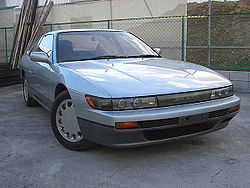
Also called Nissan 200SX (Europe)
Nissan 240SX (North America)Production 1989–1994 Body style 2-door convertible Platform Nissan S platform Engine 2.4 L KA24E I4
2.4 L KA24DE I4
2.0 L SR20DET I4
2.0 L SR20DE I4
1.8 L CA18DE I4
1.8 L CA18DET I4Transmission 4-speed automatic
5-speed manualWheelbase 2474 mm (97.4 in) Length 4521 mm (178 in) Width 1689 mm (66.5 in) Height 1290 mm (50.8 in) Curb weight 1224 kg (2700 lb) Related Nissan Cefiro
Nissan Skyline
Nissan 180SX
SileightyThe S13 Silvia, introduced in mid-1988 for the 1989 model year, was immensely popular in Japan. The Silvia name was no longer used on export models, however; European models were now known as 200SX. In North America, the S13 was known as the 240SX. The Nissan 200SX nameplate would return on a coupe version of the B14 Nissan Sentra (1995–99). The S13 was based on the first generation Nissan Cefiro, the A31. Following industry trends, the S13 Silvia switched to relampable fixed headlights. Projector optics were offered as an option.
The S13 Silvia coupe was made from 1988 to 1994, overlapping with the S14 Silvia introduced in 1993. The Nissan Silvia used fixed headlights; whereas, the 180SX, simply a hatchback version of the Silvia, introduced at the same time used pop-up headlights. The 180SX was made until 1998. A Silvia convertible was briefly offered soon after the start of production, but it was never popular, perhaps due to high cost (3.25 million Yen in 1988), heavier curb weight, and chassis flex.
The S13 was one of the first uses of Nissan's multi-link rear suspension, the technology of which was previewed in concept cars in previous years, such as the Nissan MID4. It also offered a four-wheel steering system for the first time, known as HICAS-II. In 1990, HICAS-II was updated and renamed SuperHICAS. The S13 also saw the introduction of a viscous-type limited slip differential for some models.
S13 Silvias were initially powered by the CA18DE and CA18DET engines carried over from the end of S12 production, with an intercooler added to the CA18DET for a slight increase in stability and power. In mid 1990, (for the 1991 model year) the SR20DE and SR20DET engines debuted, offering improvements across the board in power and torque due to increased displacement and a more efficient turbocharger than was offered on the previous cars. One of the other simple changes that was made between the CA generation and the SR generation was the switch to a single colour paint job, instead of the two-tone colour sets that were previously offered. On top of this, the SR motor later debuted another variant of the platform known simply as the "purple top". Identifiable by its black and silver rocker-cover (as opposed to the traditional red/silver cover), it featured a number of minor changes, resulting in little performance gain. It is vastly different to the more powerful "black top" used in the S14 and S15 variants. Amazingly, a revised and revamped version of the Nissan SR20 engine that first appeared in the S13 is still in use today, as can be seen in the following sections of this page.
In the U.S. the S13 was replaced after the 1994 model year by the new S14 design, but lived on till 1999 in Japan with a major face lift, the 180sx Aero (Type X). this was the "Kouki" generation, while the previous was "Chouki" gen. The Kouki featured newly design tail lights a redesigned aero body kit and out fitted with an airbag . In 1998, the S13 Silvia was resurrected, in part. A variant was produced by Kid's Heart for Nissan called the Sileighty, which featured the 180SX body with the front end from the Silvia. The Sileighty style was originally created by Japanese enthusiasts for their own 180SX's, and is still a common modification for the 180SX and 240SX fastback. The Sileighty also made an appearance in a Japanese anime and manga series known as Initial D. The series (based around the Japanese motor sports of Touge and drifting) featured the Sileighty in one of the last battles of the First Stage (or first season in the anime).
The creation of the Sileighty then followed by another version of the Silvia known as the Onevia. Based on the chassis of the S13, the front end of the Silvia would be removed and replaced with the front end of a 180SX. The Onevia was never retailed as a complete car in Japan (though it was in North America: the notchback version of the 240SX was essentially a left hand drive version of the Silvia with the 180SX/240SX nose)
Trim level designation
The S13 Silvia was the first S-series car to use the J's, Q's, and K's (references to the face cards of English playing cards) designations for the different trim packages.
The J's was the base model . The Q's model offered a slightly more refined experience and received electric options and an available LSD. The K's grade received the turbocharged CA18DET or SR20DET (depending on the year of manufacture) in addition to the options offered on the Q's.
On top of the K's and Q's models, the Club and Diamond Selection packages came with specific options bundled together. For example, all K's Club Selections came with projector headlamps, a rear spoiler, and 15" aluminum wheels while all Q's models came out with Automatic Climate Control.
The Silvia A's "Almighty" was introduced in late 1992. Trim wise, the Almighty slotted between the J's and Q's, offering options not available on J's, but not including all the standard features of Q's. The only available engine/transmission was the naturally aspirated SR20DE coupled with the 4-speed automatic.
S14
This section is about this vehicle's Japanese model. See Nissan 240SX for information on the North American model.S14 Also called AREX Elite 901
Nissan 200SX
Nissan 240SX (North America)Production 1995–2000 (1995–1998 in U.S.) Body style 2-door coupe Platform Nissan S platform Engine 2.4 L KA24DE I4
2.0 L SR20DE I4
2.0 L SR20DET I4Transmission 4-speed automatic
5-speed manualWheelbase 2525 mm (99.4 in) Length 4498 mm (177.0 in) Width 1727 mm (68.0 in) Height 1288 mm (50.7 in) Curb weight 1253 kg (2762 lb) The S14 Silvia debuted in Japan towards the end of 1993. It was lower and wider than the S13. New rounded styling contributed to the illusion of a greater increase in size than actually occurred. Wheelbase and track were both increased, leading to slightly improved handling. Unlike export markets, where sales of the S14 chassis variants faltered, the Silvia remained popular in Japan.
Trim level designations were similar to the S13, however the Club Selection package was dropped. "Aero" variants of the Q's and K's were offered that featured large rear wings and mild ground effects.
The S14 Silvia K's received a new version of the SR20DET, with a slight bump in power due to the implementation of Nissan's variable valve timing system known as VTC, on the intake cam, and a larger T28 turbocharger.
There was a mild styling update to the S14 during 1996, which added aggressive-looking projector headlamps and tinted taillights to all models. Fascias and other exterior trim pieces were also revised. The turbocharger now used a more efficient ball bearing center section. This updated version is also known as the kouki (後期, literally "later period") S14, or by enthusiasts as the S14A. A similar car was sold as the second generation 240SX in the United States from 1995 to 1998. The final model year of S14 production in all markets was 2000, called the Touring Model, which had a better engine, pistons and a high throtle on lower gears.
The S14 was sold in Taiwan as the AREX Elite 901.
270R
The Nismo 270R was a limited edition vehicle developed by Nissan Motorsports. The vehicle was built on the S14 chassis but had many enhancements over the Silvia. Only fifty 270Rs were ever built and they were only produced in 1994. The '270' is in reference to the horsepower of the unique car as opposed to the displacement of the engine (as other vehicles, including the 240sx, were previously named upon). The 270R featured a vented hood, Nismo 'Edge' Aero kit, heavy duty clutch, 2-way limited slip differential, and a front mount intercooler, NISMO logo front and rear seats among other upgrades. All the 270s were painted black with 'Nismo 270R' badging above the rear wheels and a product numbered plaque in the glove compartment.
Au tech Version K's MF-T
Tuning company Au tech, has a tuned adaption of the CS14 King's variant. This includes Aero style HUD with white displays and gauges for oil pressure, boost, and voltage in the centre console, along with a MOMO steering wheel and leather gear knob. The interior trim is also revised.
Handling improvements include multi-link suspension, firmer shocks and springs, front strut brace, and a rear sway bar. A large F40 style rear spoiler and aero bodykit with Autech indicators are also fitted. An "Autech Version K's MF-T" badge and sticker can be found on the boot.
An IHI ball bearing turbo (VN14) was fitted in favour of the Garrett T28 for slightly quicker response and flow. Larger 480 cc Injectors found in the later S15 Spec R's were also fitted as well as a thicker 80 mm intercooler also found in S15's. To help expel exhaust, a higher flowing Fujitsubo Giken (FGK) exhaust was fitted.
The engine is an Autech-tuned SR20DET that produces 182kW (245HP/250PS).
According to the Autech website, the vehicle is still available at a cost of ¥2.99 million yen (US$26,875).
S15
Nissan Silvia (S15) 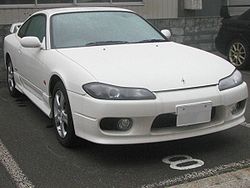
Also called AREX Elite 951
Nissan 200SXProduction 1999–2002 Successor Nissan Altima coupe Body style 2-door coupe
2-door convertibleLayout FR layout Platform Nissan S platform Engine 2.0 L DOHC-I4 (SR20DE), 165 PS 2.0 L DOHC Turbo-I4 (SR20DET), 250 PS Transmission 5-speed manual
6-speed manual
4-speed automaticWheelbase 99.4 in (2,525 mm) Length 175 in (4,445 mm) Width 66.7 in (1,694 mm) Height 50.6 in (1,285 mm) Curb weight 2650–2800 lb (1200–1270 kg) Japan saw a new version of the Silvia (S15) in 1999, now boasting 250 hp (184 kW) from its SR20DET engine, thanks to a ball-bearing turbocharger upgrade, as well as improved engine management. The SR20DE (non-turbo motor) featured 165 hp (121 kW).
The S15 Silvia included aggressive styling inside and out, updating the previous Silvia styling in-line with modern car design trends.
The S15 Silvia model lineup was initially simplified to just the Spec-S and Spec-R, both models offering an "Aero" variant with a large rear wing and side skirts/valances.
This generation of the Silvia was only sold in Japan, Australia and New Zealand but was available as a grey import in most other countries. In Australia and New Zealand the car was sold as the Nissan 200SX.
Within the Australian domestic market (AUDM), the S15 sold in 2 trim levels as noted above; Spec S and Spec R - however both models featured the SR20DET motor, albeit slightly detuned from the JDM spec cars. Nissan S15s were never officially sold with the naturally aspirated SR20DE engine in Australia or New Zealand. These two models were available at Nissan showrooms until the Nissan 200SX GT was introduced in 2002, the last year of production for the S15. Main differences here were namely the wheels being finished in a silver shadow chrome and updated larger rear wing.
The S15 was sold in Taiwan as the AREX Elite 951.
As of 2002, Nissan stopped producing the S platform with the S15-series Nissan Silvia being the final variant.
Variants
Spec-R
The Spec-R differed from previous Silvia models by featuring a 6-speed manual transmission. The Spec-R also included extensive chassis and suspension strengthening via the use of larger anti-roll bars and strut bracing. The S15 featured the same 4-piston front brake calipers that were found in the S14 but included a larger brake booster.
One of the biggest changes to the S15 model of the Silvia fitted with the 6 speed manual transmission was the implementation of a helical limited slip differential. The result was a safer, more track suited drive; in some contrast to its drifting heritage and subsequent media attention. All other versions of the Spec-R came with the viscous limited slip differential.
As with many Nissans, HICAS (High Capacity Active Steering) four wheel steering was available as an option.
Spec-S
The Spec-S featured only a 5-speed manual transmission (in addition to a 4-speed automatic available on both the Spec-S and the Spec-R). It also lacked the additional chassis support of the Spec-R; featured 4-piston front brake caliper and a slightly smaller brake booster. The Spec-S also only featured open differential.
The S15 line was later expanded to include various luxury and upgrade option packages for both the Spec-S and Spec-R. Autech, a specialty car developer, also offered several tuned versions of the S15; one with body and interior trim modeled after the Ferrari 456, called the style-A, available in both Spec-S and Spec-R based trims; and a second tuned version was based on the Spec-S trim level with the engine output increased to 200 hp (150 kW) through the use of increased compression, more aggressive camshafts, and free-breathing intake and exhaust tracts, along with ECU tuning and upgrades to the chassis and suspension. This version also included the 6-speed transmission and other upgrades normally found only in the Spec-R.
There was also a convertible variant of the Silvia, called the Varietta, featuring a folding retractable hardtop. The Varietta was built by Autech and was based on the Spec-S model, featuring the same naturally aspirated engine, with a choice of the 4-speed automatic transmission or the 5-speed manual transmission.
Production of the Silvia ended in August 2002 amidst Nissan's efforts to reduce its myriad of platforms. The S15 Silvia was therefore the last car to hold the Silvia badge. Nissan's worldwide sports car platform is now the FM Platform, which underpins the current Fairlady Z (the 350/370Z in North America), as well as the 2001–Present Nissan Skyline (the Infiniti G35/37 in North America).
In Japan, the S15 generation of the Silvia is colloquially known as the "Strawberry". The term is common, as most car enthusiasts in Japan refer to a car by its chassis name. In Japanese, the numbers one and five (from the name S15) are respectively "ichi" and "go". The word "ichigo" is also the Japanese word for strawberry.
Motorsports
The S-series is a popular drift car, especially the S13 through S15 vehicles.
Silvias have been raced successfully in the All-Japan Grand Touring Car Championship (now Super GT) and its predecessors. In the late Eighties, when Group B was banned, S110 and S12 Silvias also saw limited success in rallying, mainly on endurance rallies. During the S13's production, there was a one-make series in Japan. The S13s were also successful in racing in the IMSA GTU class during the early 1990s.
References
- ^ "Nissan Silvia". Automotive Engineering International (Society of Automotive Engineers) 107: 23. 1999.
External links
- SXOC UK 200sx owners club
- Nissan Silvia S15—Archive of Nissan's official site for the S15 Silvia. (Japanese)
- Club-S12.org - International Nissan Silvia S12 Site - International Nissan S12 Chassis specific site.
- Nissan Silvia—Australian Nissan Silvia Club.
- SilviaWA - Nissan Silvia Car Club of Western Australia
Nissan car timeline, European market, 1980s–present Type 1980s 1990s 2000s 2010s 0 1 2 3 4 5 6 7 8 9 0 1 2 3 4 5 6 7 8 9 0 1 2 3 4 5 6 7 8 9 0 1 Supermini Micra K10 Micra K11 Micra K12 Micra K13 Small family car Cherry N10 Cherry N12 Sunny B310 Sunny B11 Sunny N13 Sunny N14 Almera N15 Almera N16 Tiida C11 Large family car Stanza T11 Bluebird 910 Bluebird U11 Bluebird T12/T72 Primera P10 Primera P11 Primera P12 Executive car Laurel C31 Laurel C32 Maxima J30 Maxima QX A32 Maxima QX A33 Teana J31 Teana J32 Coupé Silvia S110 Silvia S12 200SX S13 200SX S14 Sports car 280ZX 300ZX Z31 300ZX Z32 350Z Z33 Mini MPV Note Compact MPV Prairie M10 Prairie M11 Almera Tino Large MPV Serena C23 Serena C24 Serena C25 Mini SUV Juke Crossover SUV Qashqai Qashqai+2 X-Trail T30 X-Trail T31 Murano Z50 Murano Z51 Terrano WD21 Pathfinder R50 Pathfinder R51 Off-roader Terrano II Patrol 160 Patrol Y60 Patrol Y61 Patrol Y62 Nissan Motor Company Vehicles Current370Z • Advan • Altima • Aprio • Armada • Atlas • Bluebird • Bluebird Sylphy • Cabstar • Caravan • Civilian • Clipper • Cube • Dualis • Elgrand • Frontier • Freeson • Fuga • GT-R • Juke • Lafesta • Leaf • Livina Geniss • Maxima • March • Murano • Moco • Navara • Note • NV200 • NV400 • Otti • Paladin • Pathfinder • Patrol • Qashqai • Quest • Rogue • Safari • Sentra • Serena • Skyline • Teana • Tiida • Titan • Urvan • Versa • Wingroad • X-Trail • XterraPastDC-3 • 100NX • 1200 • 310 • 180SX • 200SX • B-210 • 240SX • 240Z • 280ZX • 300C • 300ZX • 350Z • 510 • 810 • Almera • Almera Tino • Altra (EV) • Avenir • Auster • Bassara • Be-1 • Caball • Cablight • Cedric • Cefiro • Cherry • Cima • Crew • Datsun Truck • Echo • Expert • Fairlady • Figaro • Gazelle • Gloria • Hardbody Truck • Hypermini • Homy • Interstar • Junior • Largo • Laurel • Leopard • Liberty • Mistral • Multi • NX • Pao • Pintara • Pino • Platina • Prairie • Presage • Presea • Primera • President • Pulsar • Pulsar GTI-R • R390 GT1 • R'nessa • Rasheen • Roadster-Road Star • S-Cargo • Saurus • Saurus Jr • Silvia • Sileighty • Skyline GT-R • Stanza • Stagea • Sunny • Terrano • Terrano II • Vanette • VioletConcept126X • 216X • 270X • 300 Bambu • 315-a • AA-X • Actic • AD-1 • AD-2 • AL-X • Alpha T • Amenio • AQ-X • AP-X • ARC-X • AXY • AZEAL • Bevel • Boga • C-Note • Chapeau • Chappo • Cocoon • CQ-X • Crossbow • CUE-X • Cypact • Duad • Dunehawk • Effis • ESV • Evalia • EV Guide II • EV Truck • FEV • FEV-II • Foria • Forum • Fusion • Gobi • GR-1 • GR-2 • GT-R • ideo • Intima • Jikoo • Judo • Jura • Kino • KYXX • Land Glider • LEAF • LUC-2 • MID4 • Mixim • mm.e • Moco • Nails • NCS • NEO-X • NRV-II • NX-21 • NV2500 • Pivo • Pivo 2 • Qazana • Redigo • Round Box • Serenity • Sport Concept • Stylish VI • Terranaut • Tone • Townpod • Trailrunner • TRI-X • URGE • UV-X • XIX • XVL • Yanya • ZarootEngines GRX-3 • UD12 • VRT35Marques Nissan • InfinitiSubsidiaries
and divisionsSee also ATTESA • Datsun • HICAS • Prince • Renault-Nissan Alliance • Nissan Shatai • UD Nissan Diesel • VVL • VVEL • dCi
Categories:- Nissan vehicles
- Rear wheel drive vehicles
- Vehicles with four wheel steering
- Rally cars
- Sport compact cars
- Coupes
- Hardtop convertibles
- 1960s automobiles
- 1970s automobiles
- 1980s automobiles
- 1990s automobiles
- 2000s automobiles
- Vehicles introduced in 1964
Wikimedia Foundation. 2010.

